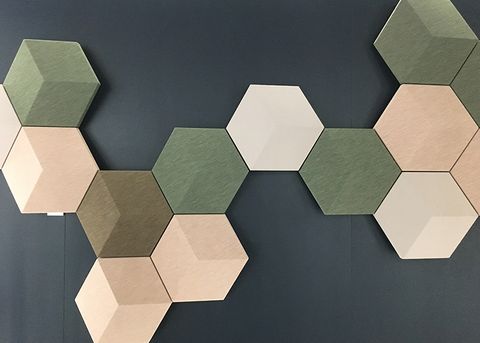Hi-fi system or wall art? Bang & Olufsen is challenging the way we experience music with the unique BeoSound Shape.
The B&O BeoSound Shape is a wireless music system unlike anything we've seen before. It looks more like beautiful wall art than a piece of technology, but it masks an extremely clever and well thought-out system that could just be the way forward for how hi-fi should look in our homes.
The specialist Danish company has always done things a bit differently - a quick look through B&O's repertoire shows TVs and speakers in interesting designs and using high-end materials - but it's with the BeoSound Shape that its drive for innovation reaches new heights.
This innovation takes a completely different approach to how a home music system should look. While there has been a general trend towards making hi-fi and AV products more lifestyle-friendly, B&O obliterates the line between traditional systems and interior design to create something completely new and exciting.
MORE: Bang & Olufsen introduces BeoSound Shape, a wall-mounted wireless speaker system
How it works
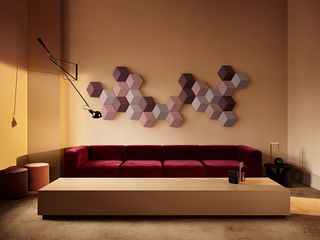
The BeoSound Shape system comprises identical hexagonal tiles that hide one of each hi-fi module - speaker, amplifier or acoustic damper - underneath its fabric cover.
There are four speakers to one amplifier and the maximum configuration you can have is 11 amplifiers and 44 speakers.
There's no limit to the number of acoustic-damper tiles you can add, and you only need one BeoSound Core for your system's wireless-streaming and connectivity features.
It's wall-mountable, and the endless combination of colours and patterns available is a huge draw when it comes to building your own stylish, bespoke system.
Design

The hexagonal tiles look identical from the outside, appearing more like a giant, colourful honeycomb nest rather than a music system.
There’s no way of knowing which tile is a speaker and which an amp or a damper unless you take the fabric covers off. (Or by touch: the amp tiles are noticeably warmer than the others.)
But that’s the point. BeoSound Shape is designed to look more like interior design than traditional hi-fi/AV, and B&O cleverly balances a minimal design with a huge scope for customisation.
The basic framework of the tiles themselves is made of a lightweight composite material, and the hexagonal shape (B&O's designers cite natural shapes such as honeycombs and snowflakes as inspiration) allows the creation of seemingly infinite patterns.

B&O enlisted leading Danish textile designer Kvadrat to dress the tiles in high quality fabric (there are standard fabric covers available too) with 10 different shades to choose from.
Colours range from the paler pink and wild-dove hues to bolder Parisian night-blue and purple-heart tiles. They complement and contrast each other, allowing you to mix and match tiles to create endless patterns and combinations.
B&O provides suggestions for how to combine the colours, which palettes work together and in what pattern to arrange them on your wall, which is helpful if you’re a complete design neophyte and need a nudge in the right direction.
Features
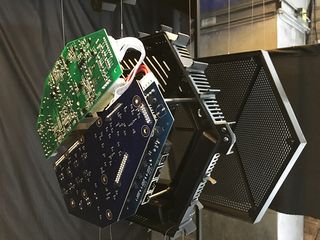
Each tile measures 36 x 32 x 11cm. That means they're not tiny; they're larger than the span of your hand.
The speakers consist of one 19mm tweeter and a 13cm mid/bass woofer, while the amplifiers are 8 x 80W class D designs.
These tiles weigh roughly 2kg, while the damper tiles are lighter at 1kg. There are four small four-wire terminals on each to connect the speakers to the amps.
Each amplifier requires its own mains-power connection (something to bear in mind if your Shape is massive), and there are connectors so you can daisy-chain multiple amps.

The puck-shaped BeoSound Core is the main wireless streaming hub for your BeoSound Shape system, and connects to the optical and USB inputs of the Shape amp.
It lets you wirelessly stream music using wi-fi, Bluetooth, Apple AirPlay, DLNA, Google Chromecast, Spotify Connect and Deezer.
All popular file formats are supported, including hi-res audio up to 24-bit/192kHz.
It also features B&O’s proprietary BeoLink system, which means you can stream from compatible BeoLink products - such as the BeoPlay A6 and BeoSound 1 wireless speakers and the BeoSound 35 all-in-one system - to form a multi-room set-up.
MORE: BeoLink Multiroom is Bang & Olufsen's new multi-room music platform
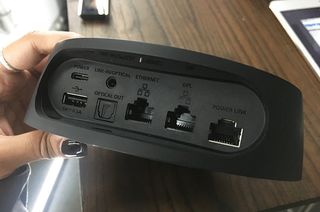
The Core is upgradable too, allowing B&O to add new specs and software updates in future without you having to overhaul your entire Shape system.
In terms of physical connectivity, you get an analogue and digital combined 3.5mm socket, one Ethernet port, PowerLink connectors, and a USB-C for power. Cable management is built into the tiles and you can also use the damper tiles to hide power adapters and rogue wires. Just remove the damping material inside.
Despite the wall-mounting nature of the product, B&O says you can set up your initial Shape system yourself. There are brackets attached to the back of the tiles (in a star-rail system) that you assemble first, place on the wall in your chosen pattern and then clip the actual tiles in place. For larger patterns, however, B&O’s team wisely recommends you ask them to sort out the installation for you.
Configuration

How do you go about creating and buying your BeoSound Shape? B&O's main focus is on customisation, and it's easily the best - and most fun - part of the Shape system.
There will be an online Configuration Tool on the B&O website once the product launches in August, through which you can pick out your new system. It’s currently in beta mode (so no pictures), but we did get a sneak preview of how it works.
The whole process is very interactive, and the interface easy to use. The website offers a selection of suggested shapes and patterns as a starting point – helpful if you’re daunted by the numerous possibilities.
Once you pick a pattern (one of them is ‘bat’, which we hope makes the final cut), an interactive diagram pops up where you can click on every single tile to change its colour, remove the tile, or add more tiles to your pattern.
It’s a bit like building a LEGO set. We can imagine getting completely addicted to this.
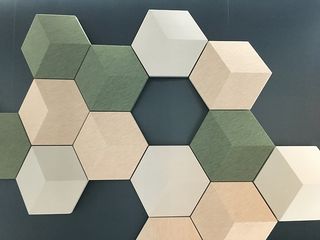
You also need to tell B&O what kind of sound you want. There’s a sliding scale that lets you choose from ‘casual’ to ‘statement’ in varying degrees, and the Shape modules are configured accordingly for optimal positioning.
The Configuration Tool keeps count of how many modules are in your arrangement as you keep adding/removing, suggests the correct ratio of amplifiers to speakers to dampers and monitors how much it’s costing you.
Once you’re happy with the end result, B&O will send you a PDF of all the details, specs and a picture of the pattern. Oh, and the bill.
Price
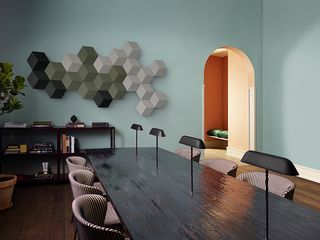
It’s not cheap. Of course it’s not cheap.
Not just because this is B&O – a brand that comes with a reputation of luxury and premium quality – but also because of the ambitious, innovative nature of this venture.
The starting price is £2605 – for which you get the basic starter kit of six tiles: two speakers, one amp, two dampers, and one BeoCore.
But that’s not set in stone; you can get different configurations of that initial set up in six- and eight-tile systems, as follows:
Six tiles: two speakers, one amp, two acoustic dampers, one BeoCore = £2605
Six tiles: four speakers, one amp, one BeoCore = £3095
Eight tiles: four speakers, one amp, two acoustic dampers, one BeoCore = £3305
Those figures aren't too extravagant considering the amount of modules and tech you get with that initial purchase. But start adding more tiles to make attractive wall-spanning art in your home and the price will creep higher and higher.
You can carry on adding extra modules to expand your BeoSound Shape, with most of the tiles available to buy in pairs:
Two speakers - £595
Two acoustic dampers - £105
Standard covers - £105
Kvadrat covers - £215
Amplifier (single) - £995
Sound
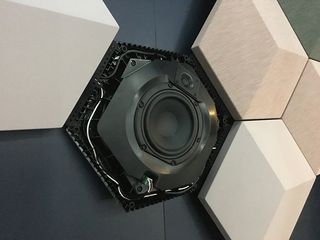
The design of the BeoSound Shape may be the biggest talking point, but don’t think B&O hasn’t thought carefully – and creatively – about how it sounds as well.
The first thing B&O decided to do was get rid of traditional left and right channels, eliminating the ‘sweet spot’ – which simply wouldn’t work with this wall-spanning speaker system.
Instead, B&O uses a ‘unique upmixing algorithm’ to spread sound evenly across the Shape speakers, ensuring that you get a focused sound no matter where you stand in front of your Shape system. In our demo of the BeoSound Shape, that definitely seemed the case. We walked the length of the system and the vocals were always centred, with instruments spaced out around.
There were some pockets where the sound wasn’t quite as strongly focused, but only close-up to the tiles. In a normal room, you’ll be standing far enough from the system for the sound to appear to come uniformly from the Shape.
The basement of London’s Fabric nightclub isn’t the best place to judge hi-fi sound quality, but we did get a sense of how loud and dynamic the Shape system can be. The spread of sound seemed even, and vocals shone clearly through punchy basslines and sparkly highs.
While we wait for the BeoSound Shape to make its way to our listening room walls we can’t help but hope the real-life sound quality matches up to the system's potential – it’s such an interesting, exciting way forward for music systems that the performance needs to be of an equally high standard.
Initial verdict
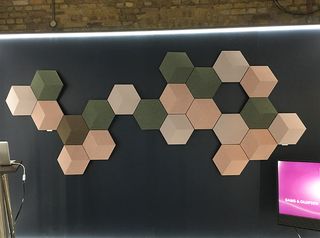
We love the idea. The BeoSound Shape system looks great and its execution - from what we've seen so far - is truly impressive.
It's a huge departure from black boxes stacked upon each other - an approach that has dominated the way hi-fi looks for decades - but we think that, with the BeoSound Shape, B&O has hit on exactly the right combination of technology, design and customisation.
The high price tag and installation aspect of the Shape will deter many - it won't be within the scope of most music fans - but we're hoping current hi-fi/AV companies take note from B&O and adopt a similar approach to future systems.
With changing lifestyles and habits, and with technology infiltrating every aspect of our lives, it only makes sense for the way we experience hi-fi to evolve.
If this is how the future of hi-fi is taking shape, count us in.
